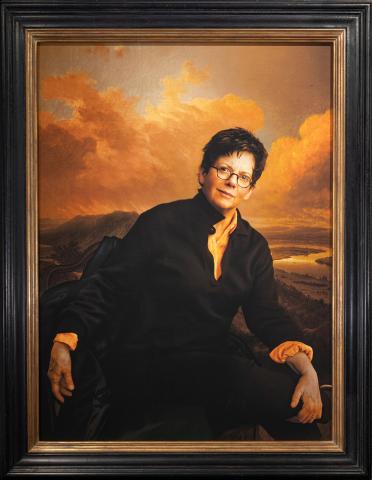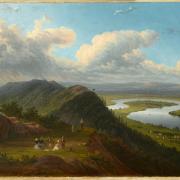as told to Katharine Whittemore

Portrait by Annie Leibovitz; click the photo for a larger version.
To me, it fits utterly in the tradition of Grand Manner portraiture. There’s an important sitter on a high promontory, yet placed close to the viewer, overlooking a noted landscape down below. The point of placing a subject of this sort--a leader--above a landscape that represents a familiar landmark (here, the Oxbow), is to show their command over all they survey.
What makes Grand Manner portraiture grander, often, is that the portrait subject’s head is seen against the clouds. Divine light is coming down illuminating their head, so it looks like there is some relationship with the divinity that guides their leadership.
At the same time, it’s meant to be seemingly casual. Though it's in a fancy portrait style, Biddy is leaning engagingly to one side. Her legs are crossed informally, one held with her hand, and one sleeve is rolled up, the other is rolled down. One side of her collar is up, the other is down. This all makes the person look more approachable, though still in the Grand Manner style.
One of its innovative features is that the photo is juxtaposed over one of Biddy’s beloved paintings of the Oxbow. Annie has enlarged it, you can see craquelure next to Biddy’s head at left—all these cracks, so you think the whole thing is a painting. The harmony of color—the fiery orange in the background and the warm glow on her—also makes the whole thing look like a painting.
That is intentional. Annie Leibovitz said she sat in Johnson Chapel and looked at the portraits of previous presidents that line the walls. She wanted to make sure Biddy would have her place there, so she visibly inserted Biddy into the genealogy of the wonderful past leaders of Amherst College. Annie made it look so much like a painting, I think, so that it harmonizes with all those gents. Yet by what she did, Annie is gently upending the tradition of representing male authority.
Because of that, the portrait bounces off the wall.

This is a witty thing Annie is doing. Of course, we are very aware that Biddy is a woman. To put her in the tradition of Grand Manner painting is a little bit funny, a little bit ironic. It’s also fantastic. Yes, she is someone who is in the line of great men. That is the thing that struck me first when I saw it.
More on the studied casualness of the pose: Past artists painted sitters with informally crossed legs and in unstable poses to suggest lifelike movement. I like how Biddy's left hand is holding her right leg. One shoulder is back, another is forward. That’s the same kind of contrapposto that Leonardo invented for the Mona Lisa. It was a new thing that Leonardo did at the time to emphasize Mona Lisa’s living, breathing presence.
To add to that, Biddy has very expressive hands, and there’s a little smile on her face. The fiery warm glow that suffuses her is not about the time of day or time of life. There is no allegory, no sunset meant to represent aging. People are always saying that. But I hate that idea!
To me, it’s not sunset or sunrise. The fiery character of the painting speaks to me about Biddy’s fiery character. She is impassioned. She threw herself, heart and soul, into leading Amherst. She did not hold back; she was in no way cold or impersonal.
What is her expression trying to say? People are always asking that about the Mona Lisa. She has a little smile. There’s a similar little smile here. To me, Biddy’s expression is a bit mysterious. It’s like a funny thought came into her mind, a witticism, but she’s not going to say it. She has a gently furrowed brow. She’s looking up from, not at, the viewer. This gives me the feeling she’s cogitating, thinking. There’s a sense of fun too.
That’s the great thing about portraits. You can’t tell what someone is thinking, because people are complex.
On Biddy’s left hand is a little glint of wedding ring. That is not unimportant: It signifies her bond with Gabi [Strauch, Martin’s wife]. An important part of her success was due to Gabi. Biddy depended a lot on having Gabi there to talk to, to get away from it all, I'm guessing. Annie Leibovitz made sure we see the wedding ring.
I have never seen Biddy dressed all in black. Usually, she’s in purple, colors, tapestry patterns. She's not wearing her academic robe, like some of the other presidents. But the sobriety is good here because it reminds you of the aristocratic portraits of old days. You can see her expressive hands and face, her relationship with the landscape. All of it is more powerful if she wears black.
The orange is meant to resonate with the clouds, her face—it’s all part of the same tonality, part of the suffusion of warmth and almost fierceness that I see there.
What Annie Leibovitz is doing is something different with modern photography; she wanted to make it look painterly. In the early days of photography, some artists tried to make photographic images be equal with painting and use painterly effects. But later that fell out of fashion: Photography could be its own art, not be beholden to painting. What’s ironic is Annie going back to that earlier time. It’s a brilliant move to make the portrait very much like a painting so that it finds its proper place in this group of portraits in Johnson Chapel.
But this one will blow all the other ones out of the water.